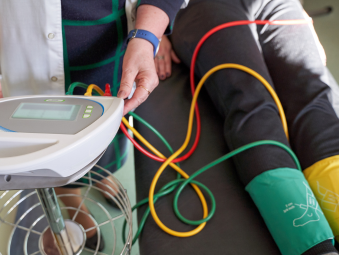Overview: Peripheral Artery Disease (PAD)

Peripheral artery disease (PAD) is a condition in which narrowed arteries reduce blood flow to the limbs, usually the legs. It’s typically caused by atherosclerosis, the buildup of plaque inside the arteries, which restricts blood flow to the muscles and tissues. PAD commonly affects the arteries in the legs but can also occur in the arms, stomach, and head.
Symptoms of PAD can vary depending on the severity of the condition, but they often include:
- Claudication: Pain, cramping, or weakness in the muscles of the legs, particularly during physical activity such as walking or climbing stairs. This discomfort usually goes away with rest and is caused by the muscles not receiving enough oxygen-rich blood.
- Numbness or tingling: Some people with PAD may experience numbness, tingling, or a sensation of coldness in the affected limbs.
- Changes in skin color or texture: Skin on the legs may appear pale or bluish, and the affected limb may feel cool to the touch.
- Slow-healing wounds: Reduced blood flow can impair the body’s ability to heal, leading to slow-healing wounds, especially on the feet or legs.
- Gangrene: In severe cases of PAD, tissue damage due to reduced blood flow can lead to gangrene, a condition characterized by tissue death.
- Impotence: PAD can also affect blood flow to the genitals, leading to erectile dysfunction in men.
Early diagnosis and treatment of PAD are important for preventing complications such as limb ischemia (reduced blood flow leading to tissue damage) and reducing the risk of heart attack and stroke. If you’re experiencing symptoms of PAD, it’s essential to consult a healthcare professional for evaluation and appropriate management.
